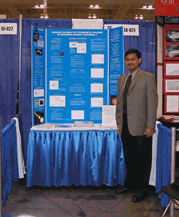Harish Khandrika stands next to a poster of his award-winning science fair project, which used data from NASA's RXTE spacecraft to study the remains from a star explosion.
Click on image for full size
Courtesy of NASA
Student Astronomer Reaches for Exploded Stars
News story originally written on July 22, 2002
Student astronomer Harish Khandrika studies the universe! He is a high school student from California who has been learning all about exploded stars, called supernovae, with Dr. Richard Rothschild at the University of California, San Diego.
Harish studied a supernova remnant called Cassiopeia A to find out how much radioactive titanium was there. Harish found that the supernova produced a huge amount of radioactive titanium!
Harish loves to study the universe, so last summer he searched for people who could help him follow his interest. Harish found Dr. Richard Rothschild who suggested he look at Cassiopeia A and his research project was born! Harish told people about his project at science fairs and won many awards. Hooray Harish!
Are you a student astronomer too? Tell us about a research project you did and we will tell you how to highlight it in our Student Projects page.
You might also be interested in:

It was another exciting and frustrating year for the space science program. It seemed that every step forward led to one backwards. Either way, NASA led the way to a great century of discovery. Unfortunately,
...more
The Space Shuttle Discovery lifted off from Kennedy Space Center on October 29th at 2:19 p.m. EST. The sky was clear and the weather was great. This was the America's 123rd manned space mission. A huge
...more
Scientists found a satellite orbiting the asteroid, Eugenia. This is the second one ever! A special telescope allows scientists to look through Earth's atmosphere. The first satellite found was Dactyl.
...more
The United States wants Russia to put the service module in orbit! The module is part of the International Space Station. It was supposed to be in space over 2 years ago. Russia just sent supplies to the
...more
A coronal mass ejection (CME) happened on the Sun last month. The material that was thrown out from this explosion passed the ACE spacecraft. ACE measured some exciting things as the CME material passed
...more
Trees and plants are a very important part of this Earth. Trees and plants are nature's air conditioning because they help keep our Earth cool. On a summer day, walking bare-foot on the sidewalk burns,
...more
There is something special happening in the night sky. Through mid-May, you will be able to see five planets at the same time! This doesn't happen very often, so you won't want to miss this. Use the links
...more















